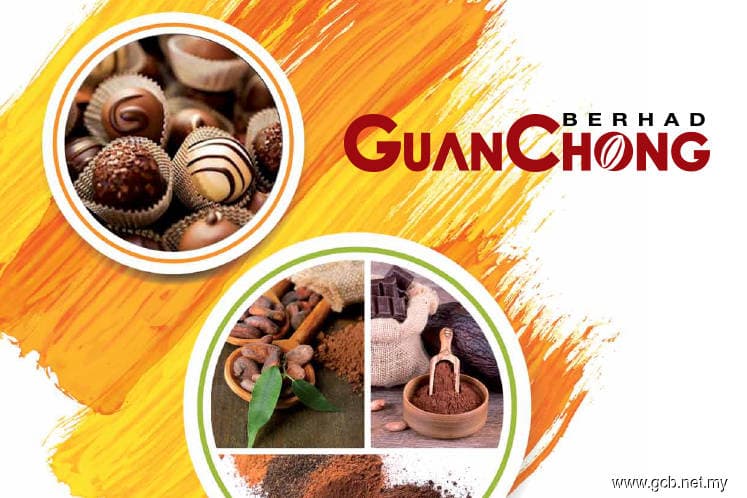
This article first appeared in The Edge Malaysia Weekly on January 21, 2019 - January 27, 2019
IT should not come as a surprise that Guan Chong Bhd’s share price has been climbing steadily over the past year, with its quarterly net profit growing by leaps and bounds.
Over the last one year, the cocoa grinder’s share price gained about 40% to close at RM2.92 last Wednesday, vastly outperforming the KL Consumer Product Index’s meagre 1.05% gain. Guan Chong is a constituent of the index.
Based on its cumulative nine-month financial performance ended Sept 30, 2018, Guan Chong’s net profit of RM126.23 million was a whopping 111.3% more than the RM58.33 million recorded in the previous corresponding period.
If annualised, its net profit for the financial year ended Dec 31, 2018 (FY2018) of RM168.31 million would surpass FY2017’s earnings of RM91.05 million by a wide margin.
Given the rising chocolate consumption in emerging economies and projections of robust cocoa production this year, Asia’s largest cocoa grinder could find itself in a sweet spot. According to news reports, the global chocolate market could grow at a compound annual growth rate of 7% between 2018 and 2024, with the increasing disposable income of emerging Asian economies expected to contribute to overall market growth.
However, this is barring dramatic volatility in the price of cocoa bean, which is influenced by demand and supply as well as market speculation. In its 2017 annual report, Guan Chong pointed out the cost of cocoa beans constitutes a large part of its raw material costs. Another factor that could hurt its revenue and earnings is the weakening US dollar, whose continuing decline against the ringgit is a concern given that most of Guan Chong’s sales are US dollar-denominated. At the time of writing, the greenback was trading at 4.12 to the ringgit.
Commodity analysts say the outlook for cocoa production this year appears strong, with ports having plenty of cocoa on offer. In its November 2018 bulletin, the International Cocoa Organisation (ICCO) reported that the 2018/19 crop year harvest has started on a strong note in Côte d’Ivoire, the largest cocoa producer in the world.
“As at Dec 2, 2018, news indicated that cumulative cocoa arrivals recorded at ports in the world’s top cocoa producer reached 689,000 tonnes, up by 35% from 510,000 tonnes seen in the same period last season,” said the report.
ICCO also highlighted a 3.9% increase in world grindings — a bellwether for demand — during the last crop season when grindings increased by 173,000 tonnes to reach a record 4.57 million tonnes.
“This new estimate reflects the unabated increase in demand, which is especially reflected in the steady cocoa processing growth in origin countries,” it added.
At the same time, Guan Chong has increased its production capacity following the acquisition of rival company Koko Budi Sdn Bhd in June 2017 for RM17 million. Some RM70 million was invested in the facility located in Pasir Gudang, Johor, with the aim to boost its overall capacity by 25%.
Currently, Guan Chong has cocoa-processing plants in Johor and Batam, Indonesia. It has cake grinding, butter deodorising and melting facilities in the US, as well as trading facilities in Singapore and Indonesia.
Guan Chong’s managing director and CEO Brandon Tay Hoe Lien told The Edge last year that the company was actively exploring the expansion of its global reach to Europe and South America to be near its end users. Tay, the largest shareholder with a 55.31% stake, also revealed that the company is prepared to invest at least RM100 million should the right opportunity arise.
In its 2017 annual report, Guan Chong said it was actively exploring the expansion of its processing facilities in origin countries to better accommodate the continued growth of global cocoa consumption.
Interestingly, Guan Chong announced last February in a filing with Bursa Malaysia that its wholly owned subsidiary, GCB Cocoa Singapore Pte Ltd, had incorporated a wholly owned subsidiary, GCB Cocoa Côte d’Ivoire, in the Ivory Coast. It said the intended principal business activities of GCB Cocoa Côte d’Ivoire are the purchase, transportation and processing of cocoa into semi-finished and finished products. The company has not announced any other plans associated with its Ivory Coast subsidiary since then.
It is worth noting that Guan Chong’s net profit has been growing from strength to strength since it suffered a net loss of RM17.56 million in FY2014, owing to depressed margins resulting from a supply glut in the cocoa ingredient market.
Net profit margin has increased from 1% in FY2015 to 4.3% in FY2017. For the cumulative nine months ended Sept 30, 2018, its margin surged to 7.6% from 3.5% a year ago.
On the back of its stellar earnings, Guan Chong’s price-earnings ratio now stands at 8.81 times. As a comparison, Singapore-listed JB Foods Ltd trades at a PER of 4.43 times.
The owners of both companies are related — JB Foods’ CEO Tey How Keong is Tay’s cousin. However, their shareholdings in their respective companies remain separate.
Save by subscribing to us for your print and/or digital copy.
P/S: The Edge is also available on Apple's AppStore and Androids' Google Play.